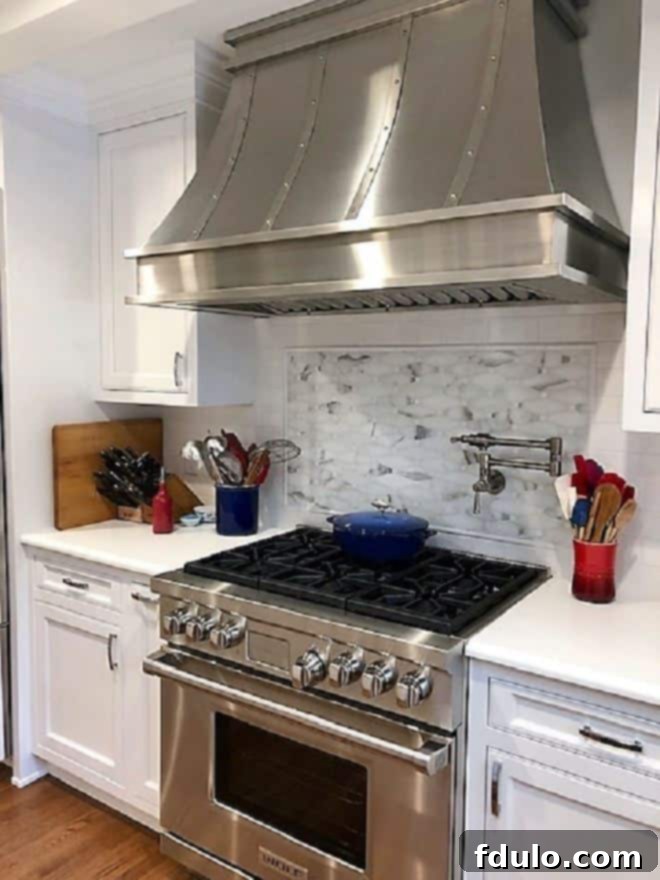Embarking on a kitchen renovation can be one of the most rewarding home improvement projects, yet it often presents a unique set of challenges. Having navigated two major kitchen remodels myself—one in 1996 and another more recently in 2018—I’ve gathered invaluable insights and practical **tips for renovating a kitchen** that can help you not just survive, but truly thrive through the exciting upheaval of your own remodeling journey. This comprehensive guide is designed to equip you with the knowledge to make informed decisions, minimize stress, and ultimately create the kitchen of your dreams.
Every renovation project typically involves unexpected detours and often extends beyond the initial timeline. However, with careful planning and a strategic approach, you can significantly mitigate potential stress. Key strategies include simplifying your daily routines, especially meals, and setting up an efficient makeshift kitchen area. These proactive steps are crucial for maintaining sanity and comfort during the weeks or even months your main kitchen is out of commission.
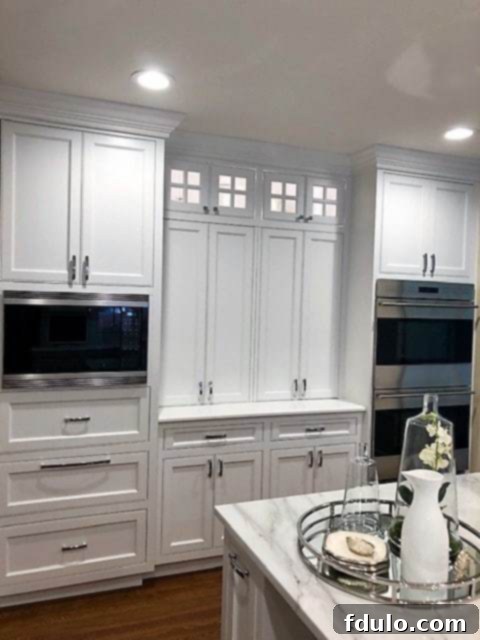
Ultimate Guide to Kitchen Renovation: Expert Tips for a Smooth Remodel
The first and most impactful reality of a kitchen renovation is that your space will likely be completely gutted for an extended period. This often means weeks, or even months, without a fully functional kitchen. Our own experience leaned towards the latter, underscoring the absolute necessity of establishing a well-organized temporary kitchen. Ideally, this interim setup should be located near a working sink to facilitate basic washing and food preparation.
Setting Up Your Temporary Kitchen: Your Renovation Survival Hub
Living without your primary kitchen doesn’t have to be a nightmare. With thoughtful planning, your temporary kitchen can be surprisingly functional.
- **Choose the Right Location:** A laundry room, utility room, or even a spare bathroom can serve as an excellent temporary kitchen. Position a sturdy card table or a similar stable surface near a sink. Ensure you have a reliable drain strainer in place to prevent food debris from clogging pipes, which can cause additional headaches during your renovation.
- **Essential Cooking Appliances:** A portable induction burner is a game-changer for preparing a variety of meals, from simple eggs to more complex skillet dishes and sauces. Remember that induction burners require magnetic cookware, such as cast iron or specific types of stainless steel, so plan your pot and pan selection accordingly. Other invaluable appliances include a microwave for quick heating, a slow cooker for easy, set-it-and-forget-it meals, and an electric kettle for hot beverages.
- **Consider Your Existing Oven:** If possible, discuss with your contractor the feasibility of keeping your current oven accessible for as long as possible. In my experience, contractors are often receptive to this request. We were able to keep our oven in its original spot until the new cabinetry was ready, then it was strategically moved to its new location. Having a functional oven, even temporarily, proved incredibly useful for roasting vegetables, baking simple treats like cookies or brownies, and maintaining a sense of normalcy. However, don’t expect to undertake complex baking projects when dishwashing is relegated to a basement sink!
- **Simplify Your Meals:** During this period, embrace simple, one-pot meals, pre-made components, and takeout options. This isn’t the time for elaborate gourmet cooking. Focus on nutrition and convenience to minimize stress. Stock up on paper plates, disposable cutlery, and easy-to-clean utensils to further ease the burden.
Smart Appliance Choices for Your Dream Kitchen
Selecting the right appliances is paramount to the functionality, efficiency, and aesthetic appeal of your new kitchen. These significant investments should align with your cooking habits, lifestyle, and design preferences.
- **Oven Configurations:** For those who love to cook, entertain frequently, or have a large family, investing in a double oven is highly recommended. In my previous kitchen, I had a single oven topped with a combination convection/microwave unit. I rarely found the convection oven convenient to use, meaning I never fully utilized its capabilities. Holidays, especially Thanksgiving with a large turkey, proved challenging with only one oven. A double oven offers unparalleled flexibility for simultaneous cooking at different temperatures, making meal preparation for gatherings a breeze.
- **Harmonizing Appliances with Design:** Coordinate your appliances with your chosen fixtures and hardware to create a cohesive look. While integrated panel-ready refrigerators and dishwashers offer a seamless, minimalist aesthetic by blending with your cabinetry, stainless steel remains a popular choice for ovens, range hoods, and other standalone appliances. I opted for paneled appliances for the refrigerator and dishwasher to create a streamlined appearance, while selecting stainless steel for my ovens, range hood, cabinet pulls, and faucets to introduce a touch of modern contrast.
- **Beyond the Basics: Refrigeration and Dishwashing:** Consider various refrigerator types such as French-door models for easy access and organization, or counter-depth models for a sleek, built-in look that doesn’t protrude into your kitchen space. For dishwashers, prioritize quiet operation (measured in decibels), advanced cleaning cycles, and practical features like third racks for cutlery or adjustable tines for accommodating various dish sizes.
- **Specialty Appliances:** Think about lifestyle-enhancing additions like a built-in microwave drawer for convenience, a dedicated wine fridge for enthusiasts, or a high-performance steam oven for healthier cooking options.
Strategic Splurges and Design Focal Points
Every renovation project has its areas where a little extra investment can yield significant returns in terms of functionality, aesthetics, and personal satisfaction. Identifying your priorities early on is key to making smart investment decisions.
- **The Allure of a Large Island:** For me, a generously sized kitchen island was a top priority. In my former kitchen, an island with a cooktop severely limited usable counter space, making food preparation cumbersome. I knew I wanted a solid slab island in my new kitchen, providing an expansive, uninterrupted workspace perfect for everything from daily meal prep and baking projects to casual dining and entertaining guests. A large island can truly transform the heart of your home.
- **The Perfect Range Hood:** A well-designed range hood is not just functional but can also be a striking design element. After years of struggling to find a range hood I truly loved, I finally discovered an image that resonated with my aesthetic. My resourceful team was able to replicate this design, creating a custom piece that became a beautiful focal point in the kitchen. Investing in a high-quality, effective range hood is crucial for proper ventilation, efficiently removing smoke, steam, and cooking odors, thereby keeping your kitchen air clean and comfortable.
- **Custom Cabinetry and Unique Finishes:** Sometimes, a splurge on custom-built cabinets or unique finishes can elevate the entire kitchen. This could be specialty woods, an intricate paint job, or unique hardware that makes a statement.
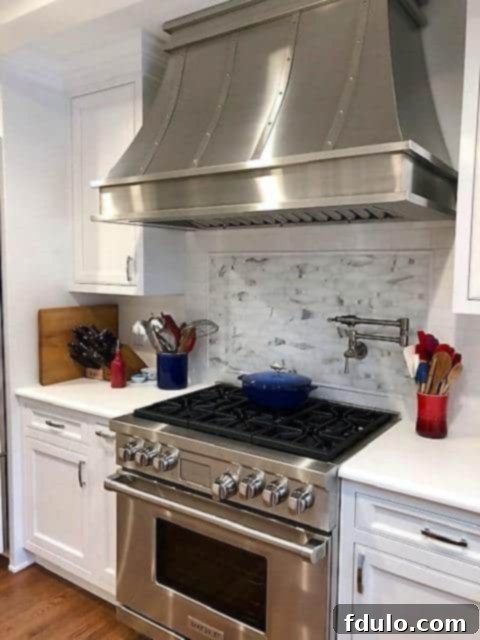
Optimizing Your Kitchen Layout for Maximum Efficiency
A well-thought-out kitchen layout is the cornerstone of a functional and enjoyable cooking space. It impacts everything from daily meal preparation to entertaining guests and should be one of the first elements you design.
- **The Kitchen Work Triangle (or Zones):** While the traditional “work triangle” connecting the refrigerator, sink, and stove remains a valid concept, modern kitchen design often emphasizes distinct “work zones.” Ensure these primary appliances are in close vicinity to each other to minimize unnecessary steps and maximize efficiency. In my layout, these key appliances are strategically positioned on one side of the island, with a dedicated bar area on the other, creating distinct functional zones that enhance workflow.
- **Ample Counter Space for Preparation:** A good-sized counter area dedicated to food preparation is indispensable. My request for a large island proved invaluable, offering an expansive surface perfect for intricate multi-step recipes, baking projects, or simply spreading out groceries after a shopping trip. Consider how your counters will be used most often and design for that purpose, ensuring uninterrupted stretches of workspace.
- **Traffic Flow and Accessibility:** Think about how people will move through your kitchen. Ensure pathways are clear, especially around the refrigerator, oven, and sink. Avoid placing obstacles that could disrupt the flow during busy times, particularly when multiple people are in the kitchen. Consider appliance door swings and cabinet clearances to prevent collisions.
- **Integrated Storage Solutions:** Plan for adequate storage from the outset. Incorporate walk-in pantries or pull-out pantry cabinets for bulk items, deep drawers for pots and pans, and various cabinet types (upper, lower, specialty) to house all your kitchen essentials efficiently and accessibly. Every item should have a logical home.
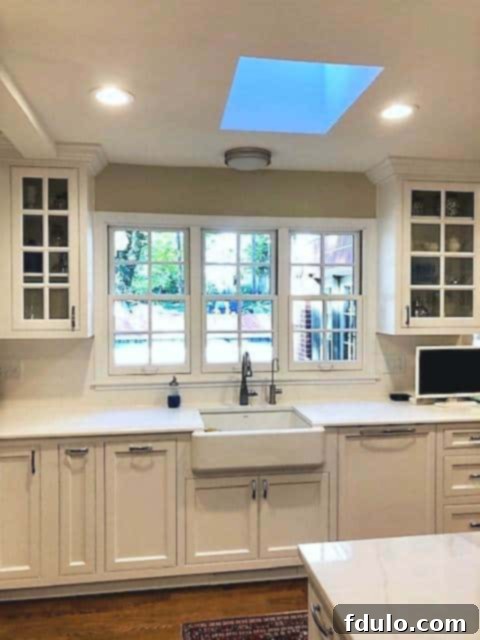
Crafting the Perfect Workspace and Illuminating Your Kitchen
The materials you choose for your workspace and the lighting design you implement will significantly impact the usability, mood, and overall ambiance of your kitchen. These elements work hand-in-hand to create a truly inviting space.
- **Uncluttered Counters for Maximum Utility:** To maximize available workspace and simplify daily routines, I prefer to keep my counters relatively free of decorative items. This approach ensures that all surfaces are immediately available for cooking, chopping, and preparation, eliminating the need to constantly move things around before starting a task. Minimalism on countertops can greatly enhance perceived space and efficiency.
- **Choosing Your Countertop Material Wisely:** The selection of your countertop material is a crucial decision, balancing aesthetics with durability and maintenance requirements. I chose a beautiful marble for my island, specifically because it allows me to place hot dishes directly on its surface without fear of damage. It’s important to note, however, that marble is a porous stone and will etch when exposed to acids, such as citrus juices or tomato sauces. Promptly wiping down any spills is essential to maintain its pristine appearance. Other popular options like quartz offer excellent durability and low maintenance, while granite provides natural beauty with good heat resistance. Butcher block can add warmth but requires regular oiling and sealing. Concrete offers an industrial aesthetic, and stainless steel provides a professional, hygienic surface.
- **The Power of Layered Lighting:** Good lighting is transformative in a kitchen, serving both practical and aesthetic purposes. We expanded the window above the sink and added a skylight, dramatically increasing natural light and making the space feel more open and cheerful throughout the day. But natural light isn’t enough; layered artificial lighting is key for functionality and mood:
- **Under-cabinet lighting** is invaluable for task illumination, brightening your work surfaces for safe and efficient food preparation, and creating a soft, inviting ambiance for entertaining.
- **Pendant lights** above the bar and island add visual interest, define specific zones, and provide focused task lighting where needed. Combined with the skylight, these features are especially appreciated during the dreary winter months, bringing much-needed brightness and warmth to the space.
- **Rope lighting** installed within glass-front cabinets not only provides subtle ambient light but also beautifully showcases decorative items, glassware, or cherished collections, adding a touch of elegance and depth.
- **Recessed lighting** (often called pot lights or can lights) provides general ambient illumination, ensuring the entire space is well-lit without creating harsh shadows. Utilize dimmers on all light sources to control the mood and brightness.

Innovative Sink Solutions and Smart Cabinetry
Beyond aesthetics, the functionality of your sinks and the intelligence of your cabinetry design can dramatically improve your kitchen experience, making daily tasks more efficient and enjoyable.
- **The Versatility of a Farm Sink:** Instead of the traditional double sink found in my previous kitchen, I opted for a spacious farm sink. Its wide, single-bowl design makes cleaning large items like cookie sheets, roasting pans, and bulky pots significantly easier and less cumbersome. Consider sink materials like durable stainless steel, scratch-resistant composite granite, or classic cast iron for varied aesthetic and functional benefits. Pair it with a high-arch pull-down faucet for maximum utility.
- **Adding a Secondary Prep Sink:** For those who entertain frequently or have multiple cooks in the kitchen, a second, smaller prep sink can be a game-changer. We installed one on the north wall, strategically positioned next to a couple of refrigerator drawers dedicated to beverages. Above this area, glass-faced cabinets filled with wine and cocktail glasses complete a perfect bar zone. This setup creates an ideal, self-contained area for serving drinks to guests or for quick rinsing of produce, all without interfering with the main cooking activities.
- **Investing in Specialty Cabinets:** Strategic splurges on specialty cabinets can truly elevate the functionality and organization of your kitchen. I incorporated two narrow, pull-out spice drawers, keeping my spices organized and easily accessible right next to my cooking zone. Another narrow pull-out cabinet was dedicated to my cutting boards, ensuring they are always within reach but neatly tucked away, freeing up valuable counter space. Furthermore, drawers designed specifically for dishes, featuring a pegboard base, help to securely hold plates, bowls, and other dinnerware in place, preventing shifting, chipping, and making them easier to access.
- **Sustainable Renovation: Reusing Old Cabinets:** Don’t overlook the potential for reusing existing elements. I was fortunate enough to repurpose my old kitchen cabinets in my new laundry room. After a fresh coat of paint and some new hardware, they look absolutely amazing and provide excellent storage, demonstrating how recycling can be both practical and aesthetically pleasing. Consider their use in a garage, basement, or even a home office.
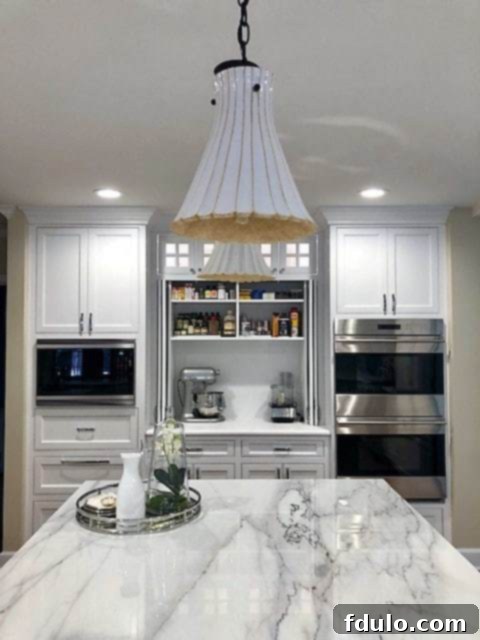
Designing a Dedicated Baker’s Kitchen: The Ultimate Baking Center
For avid bakers, a dedicated baking center is more than a luxury; it’s a necessity that transforms the baking experience, making it more efficient, enjoyable, and mess-free. My love for baking fueled the desire for an appliance garage, ensuring my stand mixer and food processor were always at hand yet neatly out of sight.
- **The Appliance Garage with Fold-Back Doors:** The beauty of a well-designed appliance garage lies in its seamless functionality. The cabinet doors are engineered to fold back and recess completely, ensuring they are entirely out of the way when the appliances are in use. When not in use, the doors can be effortlessly brought forward, discreetly concealing the small appliances and maintaining a clean, uncluttered counter appearance. The top image in this article vividly illustrates these doors in their closed position, showcasing a streamlined look.
- **Integrated Lighting and Smart Storage:** To further enhance usability, the cabinet maker installed internal lighting within the appliance garage. This brightens the workspace and makes it easier to access items, especially in darker corners. Shelving positioned above the counter within this center provides convenient storage for frequently used baking supplies, such as various extracts, essential spices, chocolate bars, baking soda, and baking powder, keeping them organized and readily available, eliminating the need to search through pantry shelves.
- **Strategic Power Outlets:** A crucial detail often overlooked in kitchen design is adequate power. My baking center alcove features no less than four electrical outlets. This thoughtful provision allows my stand mixer and food processor to remain continuously plugged in, saving time and effort during baking sessions. Simultaneously, it leaves additional open outlets for other kitchen tools like a hand mixer, immersion blender, or scale, ensuring maximum flexibility without the hassle of constantly plugging and unplugging appliances.
- **The Marble Island Advantage for Bakers:** The marble island serves a dual purpose for bakers. Its naturally cool surface is ideal for rolling out delicate pie crusts, pastries, and cookie dough, preventing butter from melting too quickly and ensuring a flaky texture. Additionally, its heat-resistant properties make it a perfect, safe landing zone for hot cookie sheets and baking pans straight from the oven, protecting other countertop surfaces from heat damage.

Discover more design inspiration: observe the inviting breakfast bar in the background, clever serving pieces and trays storage, and the ample space of the large island from a side view.
Essential Renovation Considerations for a Seamless Project
Beyond the design elements, a successful kitchen renovation hinges on meticulous planning and careful management of the entire project.
- **Budgeting Wisely:** Establish a realistic budget from the start and allocate funds for each aspect of your renovation, including demolition, structural changes, materials, appliances, and labor. Always include a contingency fund (10-20% of your total budget) for unexpected issues that inevitably arise, such as plumbing surprises or unforeseen electrical work.
- **Hiring the Right Professionals:** Research and vet contractors, designers, and tradespeople thoroughly. Look for experience specifically in kitchen renovations, excellent communication skills, and positive references. Request to see portfolios and check licenses and insurance. A strong, trusting working relationship with your team is crucial for a smooth project.
- **Understanding the Timeline:** Be prepared for your renovation to take longer than anticipated. Factors like material delays (especially with custom orders), unforeseen structural issues discovered during demolition, and scheduling conflicts with various trades can all impact the completion date. Patience and flexibility are virtues during this process.
- **Living Through the Renovation:** Plan how you’ll manage daily life without a fully functional kitchen. This includes detailed meal planning, identifying alternative dishwashing solutions, and designating a “clean zone” in your home away from the construction dust and noise. Consider setting up a temporary eating area.
- **Integrating Smart Home Technology:** Consider incorporating smart appliances, lighting systems, and voice-activated controls during your renovation. Smart ovens, refrigerators, and touchless faucets can add convenience, energy efficiency, and modern appeal to your new kitchen, enhancing its long-term value.
- **Sustainability in Design:** Explore eco-friendly materials, energy-efficient appliances, and sustainable practices. From reclaimed wood for accents to low-VOC paints and locally sourced materials, there are many ways to make your kitchen renovation greener and more environmentally responsible.
- **Final Touches and Decor:** Once the major work is done, don’t rush the final decorating. Take time to select bar stools, window treatments, art, and accent pieces that truly complement your new kitchen’s style and your personal taste. These details bring your vision to life and make the space feel truly yours.
A kitchen renovation is a significant undertaking, but with careful planning, smart choices, and a positive attitude, it can result in a truly transformative space that you’ll love and enjoy for years to come. By considering these expert tips and lessons learned, you’re well on your way to navigating your remodel successfully and creating a kitchen that is both beautifully designed and highly functional.
Have you recently completed a kitchen remodel, or are you planning one in the near future? What are some of your invaluable tips for renovating a kitchen that you’d like to share? What are your favorite features or aspects of your newly remodeled space? Share your insights and experiences in the comments below – your advice could inspire and assist countless others on their own renovation journeys!
